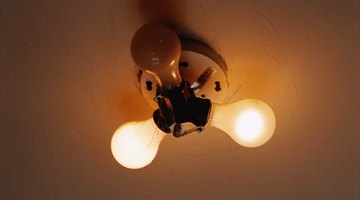How to Float a Ceiling With Mud
Drywall is one of the most common materials for forming interior walls and ceilings in homes and businesses. Drywall comes in large, rigid sheets that allow you to cover the underlying studs and insulation quickly. Even the most efficient drywall installation leaves behind small cracks and dips.

These imperfections are most common along the joints and the places where the nails attach the sheeting to the underlying wood. Floating, mudding and taping are all common terms for smoothing the drywall surface with joint compound. Floating your ceiling prepares this overhead surface for texture or paint.
Things You Will Need
- Plastic sheeting
- Joint compound
- Six-inch wide taping knife
- Fiberglass joint tape
- Paper joint tape
Tip
Finish your ceiling by applying texture or by sanding and painting the surface.
Warning
Always wear eye protection when working on a ceiling.
-
Cover the floor and any items in the room with plastic sheeting. Use premixed drywall joint compound or mix the dry compound with water, following the mixing instructions on the package label. Load a six-inch wide taping knife with the moist joint compound. Starting at the edge of the ceiling, press the flat side of the knife against a seam, running it along the opening to fill the crack. Swipe the excess mud off the surface of the drywall, creating a smooth surface.
-
Press a strip of fiberglass tape over the mudded seam while the mud is still damp and sticky. Center the tape across the crack, running it the entire length of the joint. Use paper joint tape along the corners of the ceiling, where the ceiling meets the walls. Moisten the joint tape in warm water and press it along the perimeter of the ceiling, centering it over the joint.
-
Apply a coat of joint compound, or mud, over the taped joints. Use the side of your taping knife to apply the mud, skimming the edge of the knife over the tape to create a smooth, thin layer that allows the tape to show through the coat. Don’t try to hide the tape and joint with a single application of mud. Floating a ceiling requires multiple, thin coats of mud. After the first coat of mud dries, spread on a second coat in the same manner. Some joints may require additional applications of mud to hide the tape and joint completely.
-
Fill in the dimples around the nail holes. Scoop the joint compound onto the broad edge of your taping knife. Holding the knife at almost horizontal with the surface of the ceiling, scrape the edge of the knife along the tops of the holes, evenly filling in each hole. Wipe off the excess mud from around the surface of the holes with the edge of the knife, leaving a smooth surface.
The Drip Cap
- Drywall is one of the most common materials for forming interior walls and ceilings in homes and businesses.
- These imperfections are most common along the joints and the places where the nails attach the sheeting to the underlying wood.
- Starting at the edge of the ceiling, press the flat side of the knife against a seam, running it along the opening to fill the crack.
- Floating a ceiling requires multiple, thin coats of mud.
- Fill in the dimples around the nail holes.
- Wipe off the excess mud from around the surface of the holes with the edge of the knife, leaving a smooth surface.
References
- Home Addition Plus: How to Install Drywall and Hang Sheetrock
- Drywall Info: Steps for Taping a Joint
- “Homeowner Basics”; Jodie Carter, et al.; 2008
Writer Bio
Laura Wallace Henderson, a professional freelance writer, began writing in 1989. Her articles appear online at Biz Mojo, Walden University and various other websites. She has served as the co-editor for "Kansas Women: Focus on Health." She continues to empower and encourage women everywhere by promoting health, career growth and business management skills.
Photo Credits
- Thinkstock/Comstock/Getty Images
- Thinkstock/Comstock/Getty Images
More Articles


